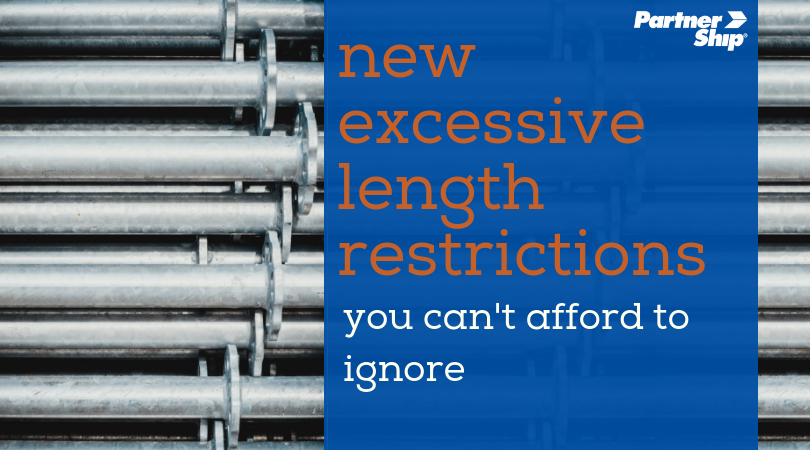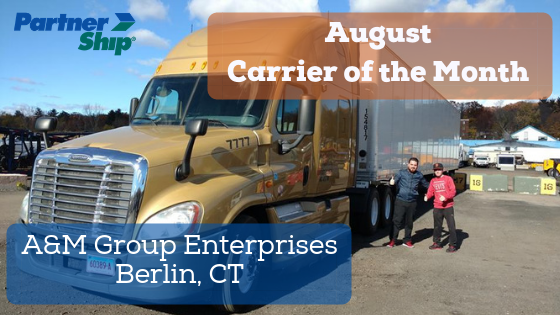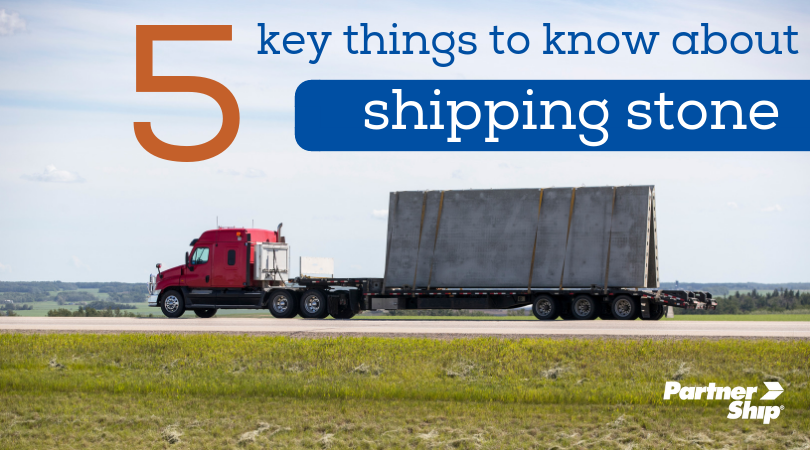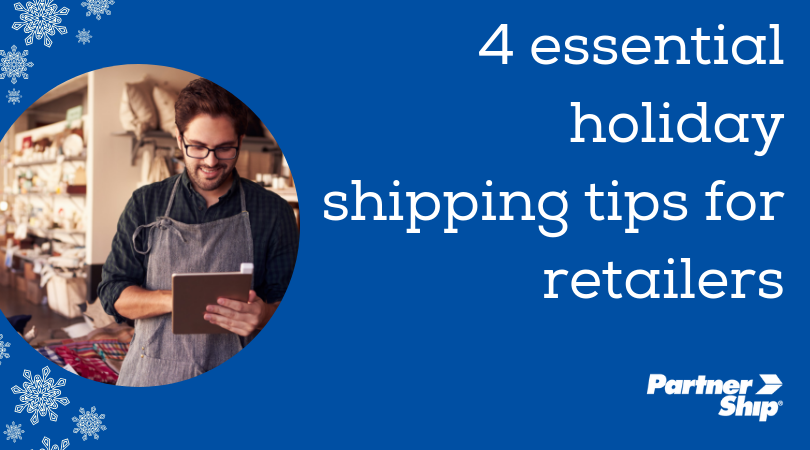the PartnerShip Connection blog
the PartnerShip Connection blog
the PartnerShip Connection blog
the PartnerShip Connection blog
the PartnerShip Connection blog
-
How to Reduce Shipping Costs: Are You Sabotaging Your Freight Spend?
09/27/2018 — Jen Deming

Shipping expenses are one of the top expenditures for most businesses, which comes as no surprise because it can be extremely challenging to determine how to reduce shipping costs. So far in 2018, US companies spent 6.2% more than they did year-over-year, totaling a record $1.49 trillion in shipping- related expenses. Many common shipping practices sabotage a business's ability to get ahead by protecting their bottom line. What are some important mistakes to avoid when figuring out how to reduce your shipping costs?
It's not always what's inside that counts.
Proper packaging is critical in helping to reduce shipping costs. We are all familiar with the risk of damages - used boxes that have holes or older labels still attached are asking for trouble. Make sure you are using the correct type of packaging materials for the product that you are moving. If you have more than a few boxes, it's a good idea to palletize all of them together, and wrap with shrink wrap. Freight shipments are loaded and unloaded at several terminal stations in route, and palletizing can keep them from being separated or lost along the way. It's also critical to use the right size packaging to help shippers reduce shipping costs. Make sure you are packaging your product with enough space inside to include proper cushioning, but not so much as to allow room for shifting or that make it difficult to handle - a carrier will charge for that too.
You are clueless about your customer's location.
Are you aware whether your receiver has a dock? How about a forklift? Are you delivering to a school, church, or another hard-to-reach area or location that risks being designated as "limited access" by the carrier? Will a 53' dry van be able to maneuver around that location? In addition to that, are hours of operation restricted for pick-ups or delivery? Every one of these variables can make a delivery potentially more difficult and more damaging to your bottom line due to costly accessorial charges. Keep in mind, the more difficult it is to get the delivery completed, the more you need to be prepared for additional fees. Planning ahead and knowing exactly what your carrier will charge for any additional services will help keep your shipping costs where they need to be.
Assuming that delivery estimate is a guarantee.
Shippers have to keep in mind that the estimated delivery day is just that - an estimate. Just as with your everyday postal service provider, business days are those included in a work week - weekends and holidays are not included. A more reliable measure to figure out shipment delivery is to take a look at transit times. When scheduling with a carrier, be sure to ask for this rather than relying on the estimated delivery date. That way, you know if your 5 day freight transit picks up on Monday, and an unexpected storm kicks up along the way, a 1 day transit delay actually results in a Monday delivery. Keep things safe by factoring in a couple extra buffer days when communicating to your customer. If you are truly in a crunch, shop the different expedited service options among different carriers, but be aware anything last minute will cost you, especially as weather worsens as we head into winter and the holiday crunch. Avoiding last minute rush shipments is always the quickest way to reduce shipping costs.
It's about 500lbs...ish?
The old adage, "measure twice, cut once" isn't just a cute lesson in being diligent - it's a very important rule for shippers to live by. Guessing just doesn't work in an industry where being a few pounds or inches off can potentially double your freight bill. Carriers check weight and dimensions once, twice, and once more just for fun with calibrated scales every time your pallet is picked up by a forklift at a terminal. If the weight of your shipment doesn't add up to what's on the BOL, you can pretty much rest assured you will be billed for the difference. If you've already quoted your customer and billed them on shipping you estimated based on inaccurate measurements, you're playing a risky game. Be sure your warehouse scale is calibrated and reset often. If you don't have a large enough commercial scale at your place of business, measure each component of your load (including pallets) and add them up. Be as thorough and as accurate as possible to avoid any surprises.
Handing the reins to your vendor.
You may love your vendors, but lots of businesses take for granted the cost- cutting potential that's available by managing their own shipping. If you are able to do so, it pays to take a look at what carrier and service your vendor is using to deliver your freight and take control of your inbound options. Some carriers have more competitive lanes in certain regions, while others may offer additional options and less expensive fees for extra services your business may require. If you are responsible for your inbound freight costs, it's worth it to put in the time to measure which carrier and service really work best for you. The additional responsibility doesn't have to be a headache, either. By working with a quality 3PL, you can make sure you are using the correct carrier, correct service level, at the most competitive price. It's a surefire way to be sure you are reducing your shipping costs where you need to.
Figuring out how to reduce shipping costs starts with some simple best practices. Double checking your specs, being knowledgeable about your transit and locations, and researching carrier options help keep you prepared and proactive about avoiding higher freight costs. When you are stuck or simply need some experts on your side, PartnerShip can help make sure you are setting yourself up for success. To speak with a specialist to learn more about where you can cut your shipping costs, call 800-599-2902 or email sales@PartnerShip.com.
Learn more about common freight shipping challenges!
Click to read more... -
New Excessive Length Restrictions You Can't Afford to Ignore
09/18/2018 — Jen Deming

It's a tough time for shippers and carriers alike. It's no secret that the current capacity crunch is affecting freight rates and transit times, but now shippers are facing new excessive length restrictions as well. As the number of available freight shipments continues to increase at a record-setting rate, carriers simply cannot keep up. In an effort to free up for space for available loads, XPO will be implementing new restrictions on certain types of shipments. What are the changes being made, and what else can shippers expect from freight carriers as capacity continues to tighten?
XPO will be making a few specific changes that will affect the excessive length policies currently in place. The primary change that will affect customers is the following:
- As of 9/24, XPO will no longer pick up shipments of pipes or bars that are not crated, regardless of length. Leading up to the 24th, all items should continue to move without problem unless over 20ft or more, which would be determined at the service center level
To summarize, if you are shipping pipes or bars of any length, they must be crated - simply palletizing your load will earn you a missed pick-up. Some shippers like to save time by combining multiple commodity types of different classes onto one pallet and one bill of lading. If you are used to combining your multi-class shipments into one load, and it includes bars or pipes, crate them separately from the rest of your freight and create an individual BOL. XPO has created a packaging guide with notable rules of thumb to help properly package your shipments and gives further insight into excessive length articles.
The active phasing out of excessive length shipments by XPO is anticipated to have a favorable impact on current available carrier capacity. It's a safe assumption that other carriers may follow suit. Many common carriers do not have the specific equipment needed to properly move long freight safely and efficiently. Historically, excessive length freight contributes to more damage claim submissions and creates much more wasted space than a standard dimensional shipment. This means less freight can be loaded into a truck at a time, and this can lead to an increase in missed pick-ups and longer transit times for other shippers.
Some carriers have already adopted special charges for small package ground shipments that are considered oversized. FedEx and UPS both charge higher surcharges on these types of shipments in order to discourage shippers from moving them. These fees range anywhere from $80 up to $500 on top of regular service cost, depending on the carrier and package size. Right now, many freight carriers already have excessive length fees in place, and it's entirely possible that carriers that do continue to move oversized freight loads may implement increases or initiate the same sort of surcharge system in the near future.
For customers who are shipping commodities that are consistently rated excessive length, it may be time to consider looking into truckload service options. Moving full truckload is a great alternative for businesses shipping many pallets of product at a time, but it's also a secure and efficient option for those who have fragile, large, or high-value freight. With this option, you pay for the cost of the space you take on a full 53' truck. Freight class doesn't affect your rate, and you may have more flexibility with packaging. Added security and quicker transit times typically are additional benefits. Depending on the length of your haul, a dedicated truck may be costly, but a freight broker can help look into partial truckload options that may better fit your budget. Whatever freight shipping option works best for you, it's a good idea to look into all available choices as the transportation industry continues to evolve.
The capacity crunch is an ongoing challenge, and carriers are responding by changing the industry as we know it. Pricing for both freight and small package services is rising, and policies are being adjusted to make room for an increase in demand. Working with a quality freight broker can help steer you in the right direction and make sure you are shipping smarter. Contact PartnerShip at 800-599-2902 or email sales@PartnerShip.com today.
Click to read more... -
The August PartnerShip Carrier of the Month
09/14/2018 — PartnerShip

PartnerShip is proud to partner with many high-quality freight carriers to help our customers ship smarter and stay competitive. We love shining the spotlight on carriers that go above and beyond and provide stellar customer service.
Our August Carrier of the Month is A&M Group Enterprises, Inc. of Berlin, CT. They have been in business for more than 15 years and have a fleet of 30 power units and 35 trailers and strive to make deliveries as smooth and hassle-free as possible. At the same time we recognize A&M Group Enterprises, we'd again like to express our thanks to all drivers that keep our economy moving during National Truck Driver Appreciation Week.
The PartnerShip Carrier of the Month program was created because we want to recognize carriers that do an exceptional job helping customers ship and receive freight. PartnerShip team members nominate carriers that provide outstanding communication, reliability, and on-time performance.
For being our August 2018 Carrier of the Month, A&M Group Enterprises gets lunch and a nifty framed certificate to proudly hang on their wall. The “thank you’s” may be small but our appreciation is huge!
Interested in becoming a PartnerShip carrier? We try very hard to match our freight carriers’ needs with our available customer loads because we understand that your success depends on your truck being full. If you’re looking for a backhaul load or shipments to fill daily or weekly runs, let us know where your trucks are and we’ll match you with our shippers’ loads. If your wheels aren’t turning, you’re not earning.
Click to read more... -
5 Key Things to Know About Shipping Stone
09/12/2018 — Jen Deming

One of the most common, and most difficult, commodities being moved either LTL or full truckload is natural stone materials. These are used mostly for construction projects, both residential and commercial. The stone can be cut, crushed, blocked, or moved upright in slabs, and each come with different requirements for packaging and handling. As dense and heavy as stone is, it can be very fragile, brittle, and difficult (not to mention dangerous) to transport. Whether you are going either LTL or full truckload for your stone shipping, there's a slew of potential complications you need to be aware of in order to ship safely and securely.
1. Packing and Packaging
First and foremost, proper packing and packaging materials are very important for stone shipping. In the most ideal of scenarios, smaller freight shipments can be packed in custom crates, with built-in foam material for cushioning. The crate shouldn't be too large, and should contain minimal extra space to limit movement of the product inside. Stone material can be separated in bags within the crate for easier removal and distribution upon delivery. Customized crates can be a little pricey, but it's well worth the extra cost in security. This is especially true if you are moving through an LTL carrier. In that case, your stone will likely be loaded and unloaded several times throughout the process, both initially and through terminals during transit.
Palletizing your stone shipments is another recommended option for larger freight loads, and are often stacked with wrapping materials in between to prevent scraping. Ideally, a specialized piece of equipment should be used to transport stone shipments cut into slabs, called an A-frame. Typically, these are made of both wood and steel and include a base with A-shaped bars angling upward acting as a sturdy support for heavy slabs. They can be used for both storage and transport, and many have wheels that can be locked into place or removed. These frames can be loaded onto the truck by either forklift or crane.
2. Trailer Types
There are many truck types that are able to transport stone, and the equipment required depends on how the stone is packaged.a 53' dry van (enclosed trailer) with swing or roll-up doors will work well for most smaller shipments going LTL. Shipments are loaded at the rear, using a loading dock and forklift. If a loading dock is not available, some trailers have lift-gates, but this additional service does come with a fee and makes it more difficult to find available trucks. It's important to note that palletized shipments of stone are generally not recommended to go LTL, unless plenty of corner guards, foam or other packing materials are being wrapped with the product.
There are a few additional trailer-type options for truckload stone shipping. A flatbed is an extremely popular trailer type that is widely used for its versatility. There are no sides so the deck is open, and freight is typically loaded over the sides and the rear. A step-deck or drop-deck is a variation of a flatbed that consists of both a top and bottom deck. The lower part is designed to haul freight that may be too tall to be hauled with a standard flatbed. Additional open deck options include RGN (Removable Gooseneck Trailers), stretch RGN, or low-boys. All of these options are designed to be used for exceptionally tall or long freight loads. These open types of trailers will most likely require straps, chains, or tarps to help protect the freight from wind or weather damage and will need to be requested by the shipper so that the carrier is prepared. A conestoga is a trailer that comes with a roll-up tarp system that creates sides and a top to offer protection of the freight, which is an added benefit to fragile stone shipping. Keep in mind, due to the specialized nature of these pieces of equipment, they may be more expensive and more difficult to find.
3. Over Dimensional Concerns
It's very common for large stone orders or building materials to be over dimensional when going full truckload. Knowing what to expect when it comes to legal requirements and how your shipment may be affected are very important in planning the haul. Every state has different legal requirements for obtaining a permit in order to transport over-sized freight. There are not only restrictions on hours of operation varying by state, but also restrictions on drivers for hours of service - meaning there is less time your shipment can be on the road. As the shipper, it's crucial to plan as much as possible beforehand and to give accurate estimates for transit time. It may be smart to plan an extra day or two when communicating with your customer. Since the load will more than likely go through checkpoints in each state it travels, each stop stop can potentially hold up your load. Make sure your drivers are prepared with the necessary permits, paperwork, and commodity information (likely including product spec sheets and packing slips).
4. Insurance Coverage
Due to the fragility and potential hazards and risk for damage in shipping stone, making sure you have proper insurance coverage is crucial. Carrier liability is typically limited, especially for LTL common carriers. So, if your shipment and damaged in transit, the probability that you will receive full compensation for the value of your product is very unlikely. Usually, in LTL shipments, the payout depends on a dollar per pound amount based on the class and commodity. In order to get this payout, you will need to go through all of the necessary steps to file a claim and prove the carrier is at fault for damaging your shipment. It can be a tedious process with a very limited return. Many shippers find it much more beneficial to obtain additional freight insurance to have more complete coverage of their freight.
Truckload carriers are required by the FMCSA to meet specific primary insurance minimums. Cargo liability is the type of insurance that covers your freight while it is in transit. Typically, up to $100,000 in cargo liability is covered, but it's important to note not all types of commodities are covered. Restrictions can vary depending on insurance company, so it's always a good idea to look into purchasing additional cargo insurance to be sure your freight is covered.
5. Accessibility of Site/ Unloading Teams
Another huge challenge for shippers moving stone materials is accessibility of the pick up and delivery locations. Oftentimes, these loads are being picked up directly at the quarry, and it can be difficult for the driver of a 53' dry van or a flat bed to maneuver in these locations. Delivery can be at construction sites, or even residential lots, which poses even more difficulty for drivers. It's important to know that the driver of your delivery truck typically will not assist in the loading or unloading of your freight. And with thousands of pounds of hard-to-move, bulky product, you need to be prepared and have a well-trained and reliable team ready at your disposal - possibly even after hours. Most truckload carriers charge detention after 2 hours for loading/unloading, which means extra money in fees off your bottom line. The time can go quickly, so have any equipment and areas cleared that are needed for loading and unloading. Being better prepared on the front side can save you lots of money and time wasted later on.
Stone shipping is one of the most challenging and problematic types of freight shipping out there. It's also very common. As both commercial and residential builders are more frequently using natural stone in their designs, the demand for transporting these materials is increasing exponentially. Stone shippers have to equip themselves with as much knowledge as possible about the many issues that may arise both during and before and after transit. Being well-informed is the best way to ship as smart and as securely as possible while minimizing the potential for costly damage. Working with a freight broker can lend you some expertise from finding reliable and vetted carriers, to knowing just what type of equipment you need to get your freight to its destination safely. Contact PartnerShip for your next stone shipment!
Click to read more... -
PartnerShip Salutes America’s Truck Drivers!
09/10/2018 — PartnerShip

This is National Truck Driver Appreciation Week and PartnerShip would like to recognize the men and women who keep our economy strong by moving freight safely, reliably and efficiently.
"From the food and medicine in our cabinets, the furniture and electronics in our living rooms, and even the cars or bikes in our driveways – none of those items would be available to us without truck drivers," said American Trucking Associations (ATA) COO and Executive Vice President of Industry Affairs, Elisabeth Barna.
National Truck Driver Appreciation Week happens September 9 - 15 to honor all 3.5 million professional truck drivers for their hard work and commitment. PartnerShip is saying “thank you” with a Dunkin' Donuts gift card for drivers that move a full truckload for us during the week. It’s our small way of thanking drivers for helping our customers ship smarter.
To learn more about National Truck Driver Appreciation Week and the American Trucking Associations, visit the ATA website. To become a partner carrier, contact one of our Carrier Procurement Representatives for a setup packet at carriers@PartnerShip.com or visit our Become a PartnerShip Carrier webpage. Then check the PartnerShip Load Board and get started!
Click to read more... -
4 Essential Holiday Shipping Tips for Retailers
09/04/2018 — Jen Deming

Holiday shipping is fast approaching for retailers. Though the season of gifting and good tidings seems miles away (and most of us have probably not even begun to think about our OWN shopping lists), it's never too early to start your holiday shipping prep. You may have already brainstormed your plan of action and received some inbound items and supplies, so now's the time to make that yearly best practices list. We've compiled a few holiday shipping tips specific for retails to make sure your busy season passes smoothly.
Tip 1: Prepare your inventory and manage your inbound shipments
As the saying goes, you have to learn to walk before you run. The very first step in great holiday shipping preparation is getting your inventory and inbound shipments from vendors in order. Taking control of your inbound shipping is crucial to being set up for holiday success. Plan ahead by looking at your past holiday seasons' wins and opportunities, check industry trends, and do your best to forecast just how much product you may need to make it through your holiday season. If you feel you will need a replenishment order, communicate with your vendors to make sure they are clear on when you will need the product (and build in some extra time as a cushion). If you are able to, consider managing your own routings by selecting your own carrier and directing your vendors on your precise shipping expectations and needs. This control can give you better peace of mind that shipments are being handled reliably and to your specifications. An added benefit to managing your own inbound shipments from vendors is that you can price shop for the best service level and carrier that fit your budget.
Tip 2: Invest time in planning and budgeting
The elevated cost of shipping during holiday peak season is just a reality for shippers, but most believe it's just the price of doing business.. Budgeting and planning what you can expect to pay during the crunch can make or break your bottom line. Not only will you be spending more overall due to an increase in volume, certain carriers implement surcharges during this period, so it pays to do your research. For the second year in a row, FedEx has announced it will NOT apply a peak season surcharge on residential shipments. UPS, however, will be implementing a surcharge on those shipments from November 18 through December 1 (in line with Black Friday) and again from December 16 through December 22 (last minute rush). The surcharge ranges depending on the service, from $0.28 to $0.99 on most residential packages, which can add up as volume increases. Larger packages will also include peak surcharges by both small package carriers, with the most expensive charge costing $165 per package. Which charges apply will depend on your package dimensions and weight, so make sure to educate yourself before the holiday rush begins.
Tip 3: Take control of setting customer expectations
The best way to ensure your holiday shipping will run smoothly, specifically from the customer's perspective, is to let them know what they can expect even BEFORE they make a purchase. It's a good idea to take a look at how your business performed last year, check through any customer issues for common themes, and adjust where you may need to. Use your website to its full potential - utilize clear and consistent language that addresses shipping costs, delivery times, order deadlines, and return policies, and make sure they are easy to find. Update your FAQ section and any links that may be relevant to holiday shipping time tables or price breakdowns.
In addition to your website, be sure to use email as an additional measure to touch base with your customers. Send out communications to past customers about any new policy changes BEFORE they put in this year's order. Send order confirmations, followed up by shipping confirmations. Many businesses send out notifications for delivery attempts or completions. These added touches not only communicate effectively to your customer but leave a positive impression of your company's reliability.
Tip 4: Make your returns process easy
As we touched on in the last tip, communication with customers is key to keeping expectations realistic and managing the consumer experience during the holiday shipping season. Another area that many retailers tend to overlook during peak holiday boom is the returns process. According to the National Retail Federation, three out of every four holiday shoppers checks the company return policy before committing to making any purchase.
Every retailer can do their best to avoid returns by being sure each product listing is as accurate and updated as possible, in order to avoid most surprises when it arrives at your customer's door. However, despite all of your efforts, returns are going to happen. If your business is going to handle and accept online returns, the more you can automate the process, the easier it will be on both you and your customer. The majority of customers are not willing to pay premium for return shipping. Price is the most significant deciding factor, so don't waste time offering faster, more expensive return services. Providing pre-printed return labels, packaging, and instructions can all improve the customer experience, lessen the returns headache for your operations team, and increase future value for your brand.
Summer may only just be winding down, but retailers are already thinking of what's on winter wish lists. It's never too early for holiday shipping prep, and being proactive is the best way to avoid a stressful peak season. In addition to our tips on planning, inventory, and streamlining your returns process, it's helpful to have the experts on your side. At PartnerShip, we know a thing or two about the peak season boom. We are happy to help you ship smarter, and with less stress, this holiday season, contact us today!
Click to read more...








